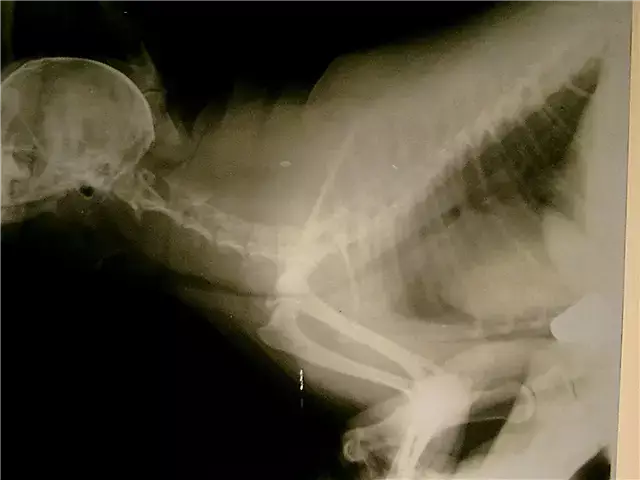- Author Rachel Wainwright [email protected].
- Public 2023-12-15 07:39.
- Last modified 2025-11-02 20:14.
Bicillin
Instructions for use:
- 1. Pharmacological action
- 2. Indications for use
- 3. Instructions for use
- 4. Side effects
- 5. Contraindications to use
- 6. Additional information
pharmachologic effect

Bicillin is a natural antibiotic of the penicillin group. The drug inhibits the synthesis of the cell membrane and walls of microorganisms, which prevents the growth and reproduction of bacteria. Bicillin is active against many gram-positive and some gram-negative microorganisms, however, most gram-negative bacteria, viruses, fungi, mycobacteria, protozoa are resistant to the action of this drug.
Bicillin is a powder for the preparation of a solution intended for intramuscular administration. Depending on the composition, there are three types of this drug:
- Bicillin 1 contains benzathine benzylpenicillin at a concentration of 300, 600 or 1200 thousand units.
- Bicillin 3 consists of benzathine benzylpenicillin, benzylpenicillin sodium salt and benzylpenicillin novocaine salt. All substances are presented in equal proportions - 200 or 400 thousand units.
- Bicillin 5 is a combination of benzathine benzylpenicillin and benzylpenicillin novocaine salt in the proportion of 1200 and 300 thousand units, respectively.
Bitsillin 1 is characterized by slow absorption after administration and entry into the bloodstream for a long period. The drug begins to act in 3-6 hours after application, and reaches its maximum concentration in 12-24 hours.
Bicillin 3 is also slowly hydrolyzed, after a single use, the concentration of the drug in the blood sufficient for treatment is observed for 6-7 days.
The maximum concentration of Bicillin 5 is reached in the first hours after administration and remains at a level sufficient for effective therapy for 28 days. An insignificant part of Bicillin is transformed, excreted mainly by the kidneys. The drug is able to penetrate the placental barrier and into breast milk.
Indications for the use of Bitsillin
Bicillin, the instruction confirms, is applied in the following cases:
- infections caused by organisms sensitive to penicillin (especially when a long-term therapeutic concentration of the drug in the blood is required);
- prevention of rheumatism;
- infections of the ENT organs and respiratory tract (tonsillitis, streptococcal pharyngitis, croupous and focal pneumonia, scarlet fever);
- erysipelas;
- syphilis, yaws, gonorrhea.
Instructions for the use of Bitsillin
The use of Bitsillin is possible only by intramuscular injection to a considerable depth. The solution is prepared just before use. According to the instructions, Bicillin can be diluted with isotonic sodium chloride solution, sterile water or 0.25-0.5% procaine solution. Before the administration of the drug, the patient should be tested for the tolerance of this antibiotic.

Prevention and treatment of infectious diseases with Bitsillin 1 occurs with a weekly (1 time per week) introduction of 300 or 600 thousand units. It is possible to use Bitsillin 1 at a dose of 1.2 million units, but then the frequency of injections is reduced to 2 times a month. Treatment of rheumatism involves the use of 2.4 million units 2 times a month, and the prevention of recurrence of rheumatism - 600 thousand units weekly for 6 weeks. An individual dosage regimen is selected for syphilis, while the recommended dose is 2.4 million units, which must be administered 2-3 times, observing 8-day breaks between the use of Bitsillin 1.
Bicillin 3 is administered at a dose of 300 thousand units (two injections into different buttocks can be made at a time) or 600 thousand units. The introduction of Bicillin 3 in a lower dosage is performed 1 time in 4 days, and in a higher dosage - 1 time in 6 days. The course of treatment for primary and secondary syphilis provides for 7 injections of 1.8 million units, with the exception of the first injection - 300 thousand units: the second administration of Bicillin 3 is carried out one day after the first injection, and the subsequent ones - 2 times a week.
Bicillin 5 is recommended for adults and children over 8 years of age to be administered 1 time in 4 weeks at a dose of 1.5 million units. For children over 8 years old, the dose of Bicillin 5 can be reduced to 1.2 million units. It is possible to use the drug in a dose of 600 thousand units for children under 8 years old - once every 3 weeks.
Side effects
The instruction for Bitsillin contains a list of negative reactions that can be caused by the use of the drug:
- headache, dizziness, tinnitus;
- bronchospasm;
- diarrhea, nausea, glossitis (inflammation of the tongue), stomatitis, liver dysfunction;
- interstitial nephritis;
- myocardial dysfunction, fluctuations in blood pressure;
- hemolytic anemia, thrombocytopenia, leukopenia, agranulocytosis, eosinophilia;
- urticaria, skin rashes, dermatitis, edema, chills, fever, anaphylactic shock, angioedema Quincke;
- superinfection (in debilitated patients) caused by microflora resistance to the drug.
Contraindications to the use of Bitsillin
The use of Bicillin is prohibited in patients with hypersensitivity to penicillins. Patients with hypersensitivity to novocaine are not prescribed Bicillin 3 and Bicillin 5.
Caution is necessary when using the drug to patients suffering from:
- hives;
- bronchial asthma;
- hay fever.
In the instructions for Bitsillin, there is no information about the use of the drug during pregnancy and lactation. Considering that the active substances of this antibiotic are able to penetrate into breast milk and through the placental barrier, the use of Bicillin should be carried out only as directed and under the supervision of a physician.
Additional Information
In order to prevent the use of Bicillin from provoking the development of fungal infections, ascorbic acid and B vitamins can be prescribed, and, if necessary, levorin and nystatin.
The instruction for Bitsillin recommends storing the drug in a dry and cool place (no higher than 20 0 C).
Bitsillin is considered suitable for 3 years from the date of manufacture.
Information about the drug is generalized, provided for informational purposes only and does not replace the official instructions. Self-medication is hazardous to health!






